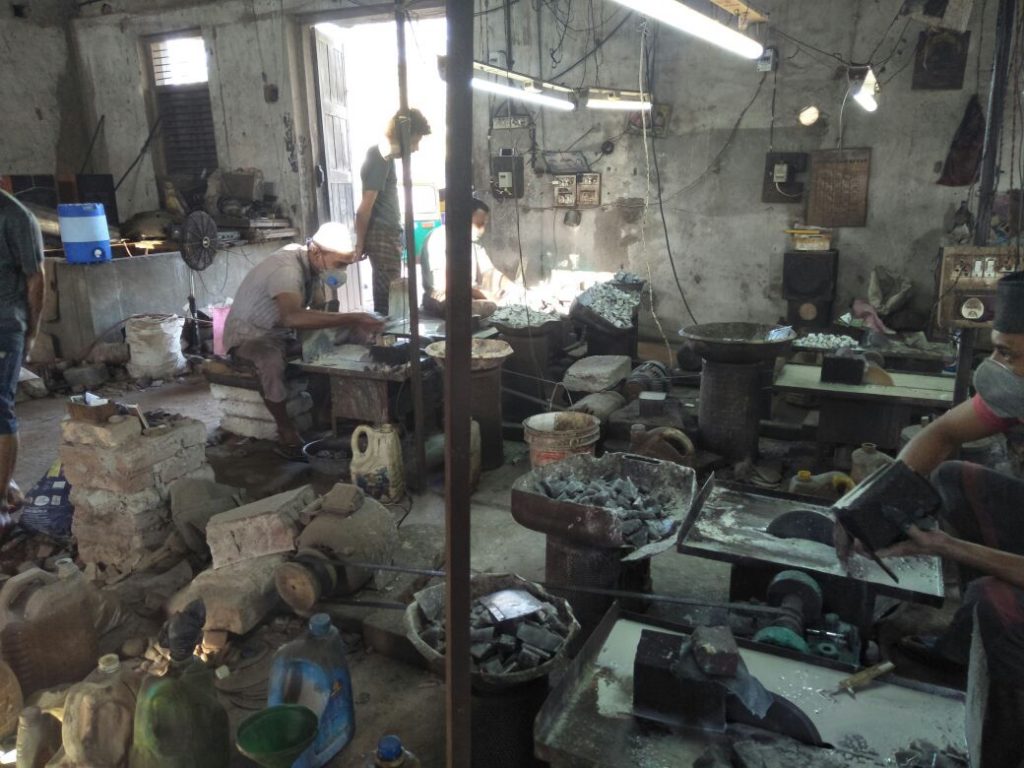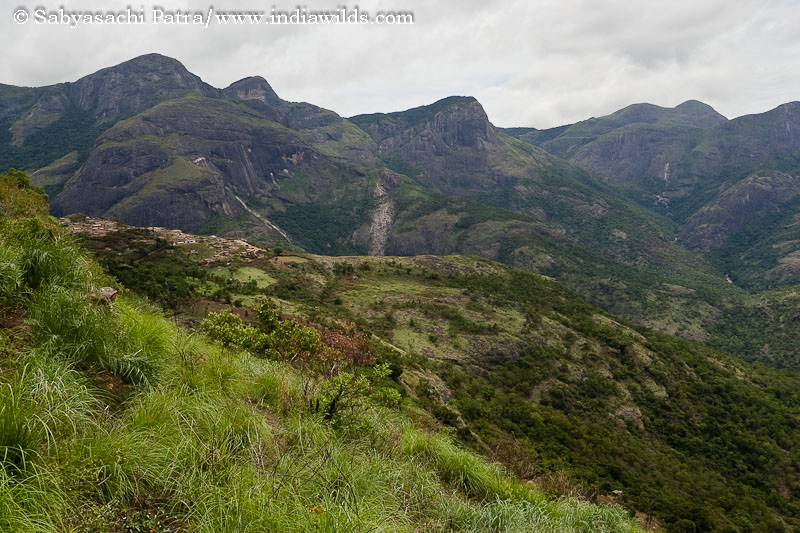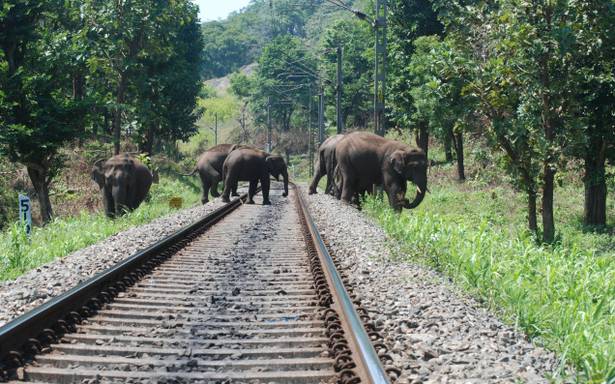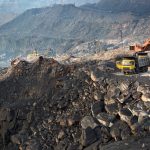IndiaWilds Newsletter Vol. 10 Issue III
ISSN 2394 – 6946
No Headlines for Nature Protectors:

IndiaWilds Newsletter March 2018
Death is always a sobering experience. One gets to introspect, reflect on the life of the departed person, his or her values and ideals and contribution to society. Between last week of February and first week of March, we got the news of two untimely deaths of persons who had diametrically opposite contribution to the society. While reflecting one often gets to wonder whether the priorities of this nation is in the right place or not. Every day one gets to see headlines of different kinds which has no relevance for the progress and wellbeing of this nation. A film star’s untimely death, though shrouded in mystery and being attributed to being the handiwork of her near and dear ones by grapevine, elicited a state funeral. An IFS officers death while discharging his duty in an accidental encounter with a tusker in Nagarhole in Karnataka didn’t barely made ripples in the newsroom desks.
Everyone wants art and craft to find its finest expression in this country and art and artists being given due honours. However, when Page 3 news becomes headlines and issues important for the wellbeing of the nation is pushed to the background, one should seriously be concerned.
According to Chanakya a king has to always respect the soldiers who treat the borders of his kingdom and the warriors who guarded the wealth of the king. A country prospers economically when its borders are protected well. Similarly the country also prospers when its wealth is protected. Unfortunately death of real soldiers dying everyday don’t even capture the attention of people. So protection of wealth other than the vaults of the banks ie. protection of rich biodiversity including mineral and oil wealth is not something which bothers the Government and people. Even the banks are defrauded as seen from host of Letters of Undertaking cases running into several billions of dollars. So it may be a tough ask to believe that the natural wealth of this country would be protected.
Sri Manikandan, a 2001 batch IFS officer was the Conservator of Forests and Director of Nagarhole Tiger Reserve. He was suddenly caught up in a charge by a tusker during a survey trip in DB Kuppe Forest Range of Nagarhole Tiger Reserve. Whereas his staff managed to escape, he couldn’t and his journey was cut short at the young age of 45 years.

Senior IFS officer S. Manikandan
The officers and staff working in the forests are engaged in protecting our natural wealth. If forests were gone, then the rivers will be gone too. Without water many a civilization have collapsed and India today with 1.34 billion people is highly vulnerable. So it is very important to give due respect to the ecowarriors engaged in protecting our ecological wealth.
It is a well known fact that the best people always compete for the most coveted jobs. Today even a pornstar can become a mainstream actress and earns way more than the best scientists, engineers and officers. At the same time, it is a well known fact that our forest staff are poorly paid, understaffed, over worked and often face the wrath of poachers and timber smugglers. In such a situation it is quiet natural that these important jobs will not have many takers. The ones who can’t get any job anywhere will finally land jobs in the forest departments. Naturally they will be ill motivated to take up this challenging task. In such a situation when a person from the officer cadre and a director of a well known Tiger Reserve passes away on duty, more could have been done to bring the issue to limelight. Nevertheless, the Hon’ble PM who is normally silent on important issues could take time to issue a condolence tweet.
There was a time when schools used to hold prayer meetings and talks about the sacrifices and martyrdom of our leaders. Their deaths used to inspire kids. Many a kid of our generation were inspired by the ideals of Subhash Chandra Bose, Bhagat Singh, Gandhi and Nehru. There used to be debate competitions where students talked about these leaders and their fight for our independence. Today the circumstances have changed. The challenges before the nation have changed. In the mad rush to shed our under-developed country tag, we have sacrificed our forests and rivers.
The wanton desecration of our ecological wealth has resulted in a brewing environmental crisis of epic proportions. Cities are becoming bigger and bigger and toxicity of the air and water in these places are becoming worse day by day. Our once dense forests are losing their species richness as well as becoming barren. Man-animal conflict is taking many lives every day. Desertification is setting in on 24.8% of India’s landmass. The spectre of Climate change induced droughts, floods and other natural calamities is going to deal serious blows in future, unless we try now to lessen those blows.
Unfortunately, some of our previous ministers in the MoEF&CC, both in UPA II and the present NDA Government have talked about sacrificing our forests and wildlife for development. People superficially talk about development vs conservation challenge without realising that everything is intricately linked. There is complete paucity of data in evaluating the impact of a proposed project on our environment and wildlife of a particular area as well as the impact of the project at the entire landscape level. Environment Impact Assessments are done for namesake in many places. And in most of the places there is high pressure from senior ministers in the central Government to give go ahead to environmentally disastrous projects. We are in a tearing hurry to tear apart our ecosystems in a few months, which have taken several million years to form.
Apart from the large projects, there have been a hitherto unseen souvenir hunting movement that is happening in the ground level which has resulted in destruction of fossils, stalactites and stalagmites and unique rock formations.

Ammonite fossil
A cottage industry has sprung up which has been using machines to cut open fossils from various places and sell it to collectors of crystals and alternate therapists.

Cutting and polishing in an industrial scale
These fossils could have yielded serious clues to our past. Even a naturally occurring shivling was hacked away from a popular waterfall and tourist place near Balasore in Odisha. Hacking away rocks, blasting caves and stalactites and stalagmites is happening at a massive scale, sometimes at the connivance of local authorities. This brings us back to the question whether the Government is indeed serious to protect our natural wealth.There is a need to enhance the level of protection of our natural wealth. To protect it, the Government has to first document it. And that needs serious investment in surveys and research and manpower. A Government which is fiscally profligate can hardly invest more in new areas when the existing projects of MoEF are getting lower budgets.
Challenge in data Interpretation:
Documenting India’s biodiversity is also facing another challenge ie of deliberately obfuscating data. For example, India’s Forest Cover study is now confusing with India’s Forest and Tree Cover. Large scale plantations have been included in the forest cover survey, so the situation projected by the Government looks rosy when it is just the reverse.
India has lost a staggering 40% of forest cover between 1880-2013 according to an ISRO Study published in Journal of Earth System Science in February 2017. This study is a part of ISROs National Carbon Project and authored by C Sudhakar Reddy, Sonali Singh, VK Dadhwal, CS Jha, N Rama Rao, and PG Diwakar from National Remote Sensing Centre, Indian Space Research Organisation, Balanagar, Hyderabad and Department of Earth and Space Sciences, Indian Institute of Space Science and Technology, Thiruvananthapuram. The authors state “The overall predicted loss of forest cover by 2025 is estimated to be 2,305 km square in the Northeast and Andaman & Nicobar Islands. The modelling results predicted widespread deforestation in these areas and hence is likely to affect the remaining forests significantly before 2025”.
However, the India State of the Forest Report 2017 which was released in February 2018, states that Forest and Tree Cover of the country has increased by 8,021 sq km (1 %) as compared to assessment of 2015. This was celebrated as a success story by the Minister for Environment, Forests & Climate Change and the official Press Release says – Dr. Harsh Vardhan pointed out that India ranks among the top ten countries of the world in terms of forest area, despite the fact that none of the other 9 countries has a population density of more than 150 persons per sq km, compared to India, which has a population density of 382 persons per sq km. “India is ranked 10th in the world, with 24.4% of land area under forest and tree cover, even though it accounts for 2.4 % of the world surface area and sustains the needs of 17 % of human and 18 % livestock population”, the Minister said. He averred that despite such tremendous population and pressures of livestock on our forests, India has been able to preserve and expand its forest wealth. Dr. Harsh Vardhan added that as per the latest FAO report, India is placed 8th in the list of Top Ten nations reporting the greatest annual net gain in forest area.
The ministry further attributes this increase in forest and tree cover largely due to the various national policies aimed at conservation and sustainable management of our forests like Green India Mission, National Agro-Forestry policy (NAP), REDD plus policy, Joint Forest Management (JFM), National Afforestation Programme and funds under Compensatory Afforestation to States. Successful agro-forestry practices, better conservation of forests, improvement of scrub areas to forest areas, increase in mangrove cover, conservation and protection activities have also led to increase in the forest and tree cover.

Shola Forests
What goes unnoticed in the India State of Forest Report 2017 is that the previous 2015 assessment had covered 589 districts in the country and the 2017 report covers 633 districts. So a 7.47% increase in number of districts covered under the survey has resulted in 1% increase in Forest and Tree Cover area in the State of the Forests 2017 report.
India is a country which will get impacted by Climate change very badly. With a long coastline and millions staying in coastal cities, the chance of inundation due to climate change induced rising sea levels is increasingly becoming more. Increased desertification, diseases, frequent natural calamities etc are soon going to be a regular feature. So it may be a pipe dream to think of solutions to lessen the impact of climate change via old style re-wilding of our barren lands using native vegetation, maintaining our existing forests and wild lands and enhancing the species richness of the existing places since the Government of the day is not ready to accept the reality. Nevertheless, these tasks and jobs have to be given adequate coverage in social media and small group interactions in schools and colleges so that the mainstream media is compelled to pick it up and the Government of the day is forced to act. Enough importance has to be attached so that it catches the imagination of the society as a whole and the new generation in particular. Else, all of us would be engaged in entertainment and other priorities while the nations ecological wealth is being razed to the ground.
Enough is Enough: #DeleteFacebook
We all have been using Social media to network, reach out to our audience and to also raise our voice. And for some social media is the sole outlet for expression and recreation. Given such disproportionate impact of social media, chiefly Facebook, it was expected that sooner than later it will blow over and cause much harm. And that dire prediction by some has come true. Facebook was earlier accused of influencing elections. Now, it has come out that the truth is much deeper.
To be fair to Facebook, it was never known for its ethics. The founder of Facebook is well known to have stolen the idea of other college mates who had employed him for coding and creating the software, nicely shown in the movie Social Network. Facebook was known from the beginning to use photos and videos of users without their permission in advertisements outside its network. Facebook also famously ignores and according to some encourages downloading of videos from youtube and uploading in facebook. The original content creators in youtube most of the times even don’t know that their videos have been ripped off and doing the rounds for free in Facebook. All of that and much more has been tolerated by people because they either knowingly ignored it or were not direct victim of it or were simply ignorant. However, the way Facebook has allowed harvesting of our personal info and its misuse by agencies to create grossly abominable outcomes is a step too far. It is happening not just in US, but in every geography including India.
Several thousand people are connected with us and have been getting information about India’s precarious environmental situation as well as getting some relief by watching soothing wildlife imagery. So with a heavy heart I announce that I am closing down my Facebook page (https://www.facebook.com/Indiawilds/) in the next few days. I will be accessible over IndiaWilds forums (https://indiawilds.com/forums ), Twitter (@indiawilds ), Google+ and by email. And I am always available over phone. #DeleteFacebook
Conservation News:
Plantation of Trees along Highways/Railways tracks
The Ministry of Environment, Forests and Climate Change has clarified that it does not implement any scheme for plantations along the highway sides and on vacant land along railway tracks. In a written reply to a question in Rajya Sabha, the Minister of State Dr. Mahesh Sharma has clarified that “the National Forest Policy (NFP), 1988 encourages plantation of trees alongside roads, railway lines, rivers, streams, canals etc. under social forestry. The Ministry in consonance with the NFP, 1988, has issued an advisory to State Forest Departments for partnering with Railways and National Highways Authority of India (NHAI) subject to the feasibility for taking up plantation of trees along the highway sides and vacant areas by the side of railway tracks. MoEF&CC also circulated Model Guidelines to all States/UTs for plantation on Railway land and plantation on sides of National Highways.
The Ministry of Road Transport & Highways has promulgated Green Highways (Plantation, Transplantation, Beautification & Maintenance) Policy-2015, under which plantations have been initiated in collaboration with Forest Departments and other agencies. No separate funds are earmarked for plantations along National Highways. Plantations are part of all National Highway projects and are undertaken as per the relevant contract provisions within the Right of Way of a national highway.
As per the information provided by Ministry of Railways, tree plantation is being done on Railway land on regular basis. At present an area of 41,417 hectares of Railway land is under afforestation.
Besides this, Ministry of Railways has also finalized a model agreement in consultation with Ministry of Environment, Forests and Climate Change to be entered between Zonal Railways and respective State Forest Department in January, 2016 for plantation of trees on Railway land along the railway track and station yards without transferring the ownership of the land in favour of State Forest Department. As per the provisions of the model Agreement, cost of the plantation including its protection and maintenance can be borne by State Forest Department or Railway Administration or can be shared by both. The plantation work on Railway land along the railway track has already been started under this agreement in some of the States. During the year 2017-18 (up to January 2018) Rs.85.25 lakh saplings have already been planted. The expenditure on plantation is done as part of maintenance of way and works. For plantation Rs.72.25 Crs. has been allotted during 2017-18 to all zones of Indian Railways.
The National Forest Policy (NFP), 1988 also envisages that tribal people and forests have a symbiotic relationship and therefore, it is the primary task of all agencies responsible for forest management, including the forest development corporations to associate the tribal people closely in protection, regeneration and development of forests as well as to provide gainful employment to people living in and around the forest.
MOEF&CC for afforestation and to increase forest cover in the country implements two Centrally Sponsored Schemes namely, National Afforestation Programme (NAP) and National Mission on a Green India (GIM). While NAP is being implemented for afforestation of degraded forest lands, GIM aims at improving the quality of forest/increase in forest cover besides cross-sectoral activities on landscape basis. These two schemes involve local people through Joint Forest Management Committees (JFMC) at the village level in the afforestation efforts and decision making in their area of implementation”.
India amends its Bio-medical Waste Management Rules
The Bio-Medical Waste Management Rules, 2016 Rules have been amended vide Notification G.S.R. 234(E) dated March 16, 2018 to improve compliance and strengthen the implementation of environmentally sound management of biomedical waste in India. The amended rules stipulate that generators of bio-medical waste such as hospitals, nursing homes, clinics, and dispensaries etc will not use chlorinated plastic bags and gloves beyond March 27, 2019 in medical applications to save the environment. However, the Blood bags have been exempted for phase-out, as per the amended BMW rules, 2018.
The amendment to the Bio-Medical Waste Management Rules, 2016 was undertaken after several rounds of stakeholder consultations, including Ministry of Health and Family Welfare, Central Pollution Control Board, State Pollution Control Boards, and Health Care Facilities.
Salient features of Bio-Medical Waste Management (Amendment) Rules, 2018 are as follows:
- Bio-medical waste generators including hospitals, nursing homes, clinics, dispensaries, veterinary institutions, animal houses, pathological laboratories, blood banks, health care facilities, and clinical establishments will have to phase out chlorinated plastic bags (excluding blood bags) and gloves by March 27, 2019.
- All healthcare facilities shall make available the annual report on its website within a period of two years from the date of publication of the Bio-Medical Waste Management (Amendment) Rules, 2018.
- Operators of common bio-medical waste treatment and disposal facilities shall establish bar coding and global positioning system for handling of bio-medical waste in accordance with guidelines issued by the Central Pollution Control Board by March 27, 2019.
- The State Pollution Control Boards/ Pollution Control Committees have to compile, review and analyze the information received and send tis information to the Central Pollution Control Board in a new Form (Form IV A), which seeks detailed information regarding district-wise bio-medical waste generation, information on Health Care Facilities having captive treatment facilities, information on common bio-medical waste treatment and disposal facilities.
- Every occupier, i.e. a person having administrative control over the institution and the premises generating biomedical waste shall pre-treat the laboratory waste, microbiological waste, blood samples, and blood bags through disinfection or sterilization on-site in the manner as prescribed by the World Health Organization (WHO) or guidelines on safe management of wastes from health care activities and WHO Blue Book 2014 and then sent to the Common bio-medical waste treatment facility for final disposal.
Measures and Policies for Tackling Climate Change:
The Union Government has said that it is taking measures and creating policies to tackle the impact of climate change in India. The Government has allocated Rs. 150 crores to the Climate Change division of the Ministry of Envrironment, Forest and Climate Change for the financial year 2018-2019.
The Minister of State for MoEF&CC in a written response to a question seeking Government’s actions on climate change has revealed “In the pre-2020 period, India announced its voluntary goal to reduce the emission intensity of its Gross Domestic Product (GDP) by 20-25 per cent from 2005 levels by 2020. According to Biennial Update Report submitted by Government of India to United Nations Framework Convention on Climate Change (UNFCCC) in 2016, India has achieved 12% reduction in emission intensity between 2005 and 2010 and is on course to achieve the voluntary goal by 2020. Under the Paris Agreement, India has submitted its Nationally Determined Contribution (NDC) to the UNFCCC outlining eight (8) targets for 2021-2030, including (i) to reduce Emission Intensity of its Gross Domestic Product (GDP) by 33 to 35 percent by 2030 from 2005 level, (ii) to achieve about 40 percent cumulative electric power installed capacity from non-fossil fuel based energy resources by 2030 with the help of transfer of technology and low cost international finance including from Green Climate Fund (GCF), (iii) to create an additional carbon sink of 2.5 to 3 billion tonnes of CO2equivalent through additional forest and tree cover by 2030. The other targets pertain to sustainable lifestyles; climate friendly growth path; climate change adaptation; climate change finance; and capacity building and technology.
To achieve the goals, Government of India is implementing the National Action Plan on Climate Change (NAPCC) which includes eight national missions being implemented by various Ministries in specific areas of Solar Energy, Enhanced Energy Efficiency, Sustainable Habitat, Water, Sustaining the Himalayan Ecosystem, Green India, Sustainable Agriculture and Strategic knowledge for Climate Change. Further, 32 States/Union Territories have prepared State Action Plans on Climate Change (SAPCC) consistent with the objectives of NAPCC. Government of India is also implementing a dedicated National Adaptation Fund to implement adaptation actions in vulnerable sectors across the country.
Unfortunately, these responses are often seen in the context of India’s action vis-à-vis other countries. There is no ground level information on the impact of Climate Change and the impact of these actions in lessening the severity of the climate change induced natural disasters and calamities. Most of these issues are inter-related and a holistic approach is needed in looking at the issues from both micro and macro level across states, landscapes and bio-diversity and climatic regions. Unfortunately that would need way more expertise and investments in scientific manpower than is budgeted at the moment.
Journalist who exposed Sandmining mowed down in MP:
Sandeep Sharma, who was working as a stringer for News World TV channel was brutally mowed down by a truck on 26th March in Bhind district of Madhya Pradesh. Mr. Sharma had earlier done two sting operations on police officers. He had sought police protection apprehending threat to his life.
He had written a letter accusing the local Sub-divisional Police Officer (SDOP) of being hand-in-glove with illegal sand mining mafia.
He was immediately rushed to a local hospital where he succumbed to injuries during treatment.
According to ANI reports, the Government has been compelled to form an SIT team to investigate the murder which has been captured in video –
#WATCH:Chilling CCTV footage of moment when Journalist Sandeep Sharma was run over by a truck in Bhind. He had been reporting on the sand mafia and had earlier complained to Police about threat to his life. #MadhyaPradesh pic.twitter.com/LZxNuTLyap
— ANI (@ANI) March 26, 2018
Jyotiraditya Scindia, leader of Congress has demanded a CBI inquiry into the incident. “He was killed in broad daylight. Nothing less than a CBI inquiry should be done. Media is the 4th pillar of democracy and that is being crushed under BJP’s rule.” It is a sad story that RTI activists and the few honest journalists are being murdered throughout the country.
Kerala wants Elevated corridor through Bandipur
Kerala wants to build an elevated corridor on the road patch passing through bandipur to circumvent the night traffic ban in NH 766 passing through Bandipur. It has also suggested having underground rail – Roll on/roll off traffic. These proposals have been submitted to the High level committee constituted by the Hon’ble Supreme Court of India. Till these proposals are operationalized the Kerala Government wants vehicles to be allowed in the night in convoys at reduced speeds.
Kerala Government has been vocal against the night traffic ban as movement of goods from Kerala side to Karnataka has been hampered. However, the Karnataka Government has been so far resolute in its opposition to the vehicular movements in the night as many wildlife deaths have happened in the night due to speeding vehicles. The animals are also not able to move from one part to the other restricting their range. This causes huge problems in food as well as genetic diversity.
However, in variance to the demands of the Kerala Government officials and local MLA, the Wayanad Prakrithi Samrakshana Samithi has submitted a memorandum demanding that there should not be any vehicle movement in the night in the forest stretch of NH-766 and the night traffic ban should continue.
Contending that the traffic passing in the NH-766 and NH-67 is huge and will cause a huge problems to the wildlife, the President of Wayanad Prakrithi Samrakshana Samithi said “The frequency of vehicles per day is estimated approximately at 4,500 and 4,000 per day at NH-766 and NH- 67 respectively. We can only imagine the pollution and disturbance they cause to the wildlife. A reprieve of nine hours a day is all we ask to help other creatures survive and co-exist on this planet.” Given that the current Central Government as well as many State Governments are ever eager to sacrifice wilderness and wildlife at the altar of infrastructure creation and commerce, the move by Karnataka Government to continue with the night traffic ban in Bandipur is a welcome change.
Indian Railways trying Sound of Honeybees to ward off elephants
Indian Railways is trying to scare away elephants using sound of honey bees. Indian Railways have become the biggest killers of wild elephants with many herds being mowed down at different stretches.

Elephants crossing
However, the railways neither want to change the alignment of the trains nor do they want to invest in creating suitable underpass for the elephants to use their route and avoid the trains. Now the railways have come out with this idea of scaring away elephants with the sound of honey bees. They have downloaded the sound of honey bees from the internet and are playing it over loudspeakers. When the gatemen sees the elephants, the bee sounds have to be played over amplifiers.
At the moment the Alipurduar division has installed this device at two points where elephants regularly cross the tracks. One has been installed at railway gate number 162 between Chalsa and Nagrakata in Jalpaiguri district and the other at gate number 126 between Kalchini and Rajabhatkhawa in Alipurduar district. This experiment has worked in Assam so the Northeast frontier railway has gone ahead with experimenting in West Bengal. The elephants need to cross the railway lines and can’t be confined to one side for long. Only when the elephants remain close to the train lines for long and trains are expected during that time the sound can be played. The long-term efficacy of this experiment needs to be observed as repeated playing of the sound in the same area may make them familiar as elephants are intelligent creatures. In Africa, they have learnt to throw trees over solar fencing to break the circuit and cross the barriers.
The long-term solution is to create alternate alignments of railway lines to skirt the elephant habitats and create suitable underpasses wide and big enough for elephants to feel comfortable and pass through. It is just a question of priorities. Unfortunately, the actions of successive Governments and politicians are mostly never in sync with the well being of its wildlife.
Equipment Discussions:
Wacom Cintiq Pro 24 inch Pen Display
Wacom has introduced the Cintiq Pro 24 inch pen display which will be highly helpful for creative and design work including virtual reality. Early Wacom had the 13 and 16 inch models. The 24 inch model was announced last year but is now finally available. According to Cintiq the pen and touch display model will be available in May 2018 and the 32 inch model will be available at a future date in 2018.

Take your creativity to a new level with Wacom’s Cintiq Pro 24 (PRNewsfoto/Wacom Technology Services, Corp.)
Cintiq has creatively come out with a Pro engine which can plug in to the Pro Pen display and convert it into a powerful workstation.
PRESS RELEASE
Wacom introduces the Cintiq Pro 24-inch pen display
Wacom extends the Cintiq Pro lineup with a new high performance mid-sized display built for cutting-edge creative and design applications including augmented and virtual reality. The Cintiq Pro family now features a range of sizes to meet the unique workflow and configuration needs of creative professionals.
TOKYO, Feb. 27, 2018 /PRNewswire/ — Today Wacom announced the availability of the Wacom Cintiq Pro 24 pen display, expanding the Cintiq Pro high-definition range, which is designed for creative professionals seeking a larger digital canvas and the power to tackle an increasing onslaught of creative applications and programs. The new 24-inch Cintiq Pro pen display joins the previously introduced 13 and 16-inch models to form a comprehensive range of sizes for every need and workspace. The pen and touch display version will be available in May, the earlier announced 32-inch model is slated for later this year.
Performance you can see and feel
The brilliant 4k display, 98% Adobe RGB color accuracy and a billion colors deliver a true-to-life visual experience. The pen on screen experience was also improved. The combination of the new Pro Pen 2 technology (improved pressure sensitivity featuring 8,192 levels), the etched glass surface, the reduction in parallax through optical bonding and the close to zero latency, provide artists with precise control and a more natural feeling pen on screen experience.
“We know that professional artists and designers are facing an increasingly vast array of computing and display demands as they embrace emerging technologies like augmented and virtual reality, and 3D, where one size doesn’t fit all,” says Faik Karaoglu, Executive Vice President for the Creative Business Unit at Wacom. “Everyone has their own way of working, and we are excited to offer larger sized digital canvases with flexibility that provides more pen space for those who need it to create.”
Transforming the workflow
With the Wacom Cintiq Pro Engine (also announced today), a Windows 10 computing module, featuring the new NVIDIA ® Quadro ® P3200 high performance graphic card, that slides into the back of the Cintiq Pro 24 display, creative professionals can easily transform their Cintiq Pro 24 into a high performance creative workstation fully supporting state of the art applications and workflows, including 3D, animation and augmented and virtual reality.

Wacom’s Cintiq Pro Engine: The first modular all-in-one creative studio (PRNewsfoto/Wacom Technology Services, Corp.)
Availability
The Cintiq Pro 24 pen display models are available in the U.S., Japan and selected European countries as of March. Prices ranging from $1,999 to $2,499. The Pen & Touch version of Cintiq Pro 24 will be available in May 2018 and finally the also announced Cintiq Pro 32-inch model is slated for later in 2018 due to a couple of unexpected supply chain issues.
Huawei Launches Mediapad M5 with M-Pen stylus
Chinese manufacturer Huawei has launched an interesting tablet with stylus branded as MediaPad M5 Pro and M-Pen. The MediaPad M5 Pro comes in two sizes, 8.4 inch and 10.8 inch. They have 359 PPI (2560×1600) 2K resolution and IPS display. It has 82% screen to body ratio which results in a wider view.
Huawei terms its pen as ultra-preciase M-Pen and it features 4,096 levels of pressure sensitivity. One can use the M-Pen to do some nice shading in sketches or simply for taking notes.
When you are playing movies, HUAWEI ClariVu™ technology uses intelligent algorithms to adjust unclear frames or drops in contrast ratio to deliver a better viewing experience. We are not sure if this technology works flawlessly.
HUAWEI MediaPad M5 supports Hi-Res audio – an industry standard for sound quality for creating a better listening experience. Tuned by the renowned acoustic legend Harman Kardon™ Audio, the tablet delivers quality sound with more bass, and no distortion. There are dual speakers with smart amplifiers. It takes only 1.9 hours to get the MediaPad M5 fully charged. Its 5100 mAh (TYP) battery and Smart Power-Saving technology allow you to enjoy 1080p videos to 11 hours.
Price of mediaPad M5 Pro 10.8 inches with 4GB+64 GB wifi is 499 euros. The price of 10.8 inches with 4GB+64 GB LTE is 549 euros. M5Pro 10.8 inches 4GB+128 GB LTE costs 599 euros. India pricing is yet to be announced.
Apple Launches entry level iPad(2018)
Apple has launched entry level 9.7 inch iPad(2018) and it supports the apple pencil stylus. At just 469 grams and 7.5 millimetres thin it is very sleek and is available in Silvery, Space Grey and Gold colours.
It has an 8 Megapixel camera at f/2.4 aperture and1080p Full HD video. It has 1.2 MP facetime camera in the front with f2.2 aperture. The iPad(2018) has 2048×1536 Pixels IPS display and 264ppi.
It has A10 Fusion chip. 64-bit architecture. Four-core design. Over 3.3 billion transistors which makes the iPad incredibly fast. Which comes in handy when you want to edit a 4K video, play graphics-intensive games or experience the latest augmented reality apps. One can also do a facetime video while browsing.
It is easy to do normal Microsoft power point presentations as well as use as notepad to quickly jot down things during a meeting or draw and highlight things. The apple pencil will help in doing pixel perfect drawings and shadings.
It is also the most easy and immersive way to experience augmented reality. Augmented reality (AR) is a new technology that brings virtual objects into the real world. And every aspect of iPad — from the display to the processing power to the cameras to the motion sensors — is designed to make AR apps more magical than ever before.
The iPad features Wi-Fi speeds up to 866 Mbps and 4G LTE speeds up to 300 Mbps.
The iPad (2018) comes in 4G LTE (on the Wi-Fi + Cellular model), Wi-Fi 802.11ac (dual-band, 2.4GHz and 5GHz), Bluetooth v4.2, and A-GPS (on the Wi-Fi + Cellular model). It has a Touch ID fingerprint sensor on the home button. There is also an ambient light sensor, digital compass, barometer, accelerometer and a 3 axis gyroscope.
The battery life is supposed to be 10 hours.
Price:
The 32GB iPad (2018) Wi-Fi model is price at Rs. 28000/-. 32GB iPad(2018) WiFi+Cellular is 38600/-
The Apple Pencil is optional at Rs. 7600/-
Till date Apple products have never been immediately available in the India market. Following that practice, India will not be the countries where it will go on sale from today. The Apple iPad (2018) will be available in India later in April.
GoPro and Jabil Announce Global Technology and Equipment License arrangement
Go Pro and Jabil have announced a global, multi-year technology and equipment license. With this agreement, Jabil will leverage GoPro’s cutting-edge reference design and IP to produce camera lens and sensor modules for incorporation into GoPro-approved third-party products and solutions. This agreement builds on GoPro and Jabil’s longstanding relationship.

GoPro Hero6 Black
“This collaborative approach with Jabil will enable innovative, GoPro enabled products and services from some of the most exciting hardware and software companies out there,” said Sandor Barna, GoPro’s chief technology officer. “Imagine a world where video conferencing, robotics, and even self-driving cars are powered by GoPro’s camera lenses and image sensors. Together, GoPro and Jabil can make this a reality.”
This agreement covers a range of products and services each company offers, including certain digital imaging and consumer products. GoPro and Jabil have a history of collaborating to bring high-quality, cutting-edge products to consumers, including GoPro’s line of HERO cameras, starting with HERO4.
“This agreement is a natural extension of our long-standing relationship with GoPro and our commitment to developing innovative technologies,” said Irv Stein, Jabil’s vice president of Jabil Optics. “Early market feedback indicates strong demand in the enterprise action camera segment for applications in smart homes, military, fire, police, rescue, and security.”
GoPro is currently in trouble as its products are not sufficiently differentiated from customer offerings and sales have plunged. Its quadcopter offering the Karma drone had to be recalled and is not selling well after the relaunch. So GoPro lost a lot of money and have closed down its copter division. GoPro is reportedly looking at suitors but nothing has materialised yet. Hopefully there will be a GoPro 7 this year and the company can come out of the Red.
Google acquires Lytro
It has been reported that Google has acquired Lytro for 40 million dollars. Lytro is a company known for its technology where the focus can be changed after clicking the image. Lytro was founded in the year 2006. They had a unique approach of capturing all the light rays hitting the sensor as well as the information from where they have come. This helps in refocusing the image after it has been clicked.

Lytro
Unfortunately Lytro despite making a splash with its unconventional ideas, have sold two cameras and they were not well received in the market. It is reported that many existing camera companies started thinking along the lines of Lytro and in future those research may converge with the existing camera technology.
Nothing has been officially announced yet regarding Google buying out Lytro. There are reports of only asset sales and only some employees going to join google. There are other reports of much lower price. It should be noted that Lytro had raised $200 million US dollars funding and was valued at $360 million during its last round of funding in 2017. Lytro had many backers including Foxconn who manufacture the iphones for apple, Qualcomm Ventures, NEA etc.
It is not clear how Google plans to use this acquisition. It is speculated that this is primarily for the 59 patents that Lytro has and it would help Google integrate these technologies in some of its future smartphone technology or in VR applications when VR finally takes off.
The future of imaging is not known. Google being one of its major consumers as well as enablers in consuming, it would always love to have a pulse in future tech including computer vision technologies. That perhaps is the reason for acquiring Lytro. Also, if Google can include the Lytro technology in smartphones, then the cost of research can be easily apportioned within the millions of smartphones sold and hence will be highly feasible. Lytro was trying to sell independently cameras which was not well liked due to the low resolution and the clunky design interface. The last word on this is yet to be heard.
Nimbus Launches 100TB SSD drive
When we are grappling for SSDs in the 1 to 2 TB range for our laptops or for recording directly from our cameras, Nimbus has launched a SSD with a whooping 100TB capacity. The company says “ExaDrive solid state drives are purpose-built for capacity, energy efficiency, longevity, and density. ExaDrive SSDs feature a patent-pending architecture, packing up to 100 terabytes of flash in the industry standard 3.5” form factor. ExaDrive SSDs enable organizations to dramatically increase storage capacity and performance while slashing data center power, space, and cooling costs.”
At the moment the SSDs are targeted for the data centres and not for individual customers. Nevertheless this technology will trickle down to consumers in the near future. So we bring you this information to tell you as to which directions the technology winds are blowing.
Nimbus Data launches the world’s largest solid state drive – 100 terabytes – to power data-driven innovation
ExaDrive DC series raises the bar in SSD power efficiency, density, and write endurance
Irvine, CA, March 19, 2018 – Nimbus Data, a pioneer in flash memory solutions, today announced the ExaDrive® DC100, the largest capacity (100 terabytes) solid state drive (SSD) ever produced. Featuring more than 3x the capacity of the closest competitor, the ExaDrive DC100 also draws 85% less power per terabyte (TB). These innovations reduce total cost of ownership per terabyte by 42% compared to competing enterprise SSDs, helping accelerate flash memory adoption in both cloud infrastructure and edge computing.
“As flash memory prices decline, capacity, energy efficiency, and density will become the critical drivers of cost reduction and competitive advantage,” stated Thomas Isakovich, CEO and founder of Nimbus Data. “The ExaDrive DC100 meets these challenges for both data center and edge applications, offering unmatched capacity in an ultra-low power design.”
Optimized to Maximize Flash Storage Capacity and Efficiency
While existing SSDs focus on speed, the DC100 is optimized for capacity and efficiency. With its patent-pending multiprocessor architecture, the DC100 supports much greater capacity than monolithic flash controllers. Using 3D NAND, the DC100 provides enough flash capacity to store 20 million songs, 20,000 HD movies, or 2,000 iPhones worth of data in a device small enough to fit in your back pocket. For data centers, a single rack of DC100 SSDs can achieve over 100 petabytes of raw capacity. Data centers can reduce power, cooling, and rack space costs by 85% per terabyte, enabling more workloads to move to flash at the lowest possible total cost of ownership.
Plug-and-Play and Balanced Performance for Diverse Workloads
Featuring the same 3.5” form factor and SATA interface used by hard drives, the ExaDrive DC100 is plug-and-play compatible with hundreds of storage and server platforms. The DC100’s low-power (0.1 watts/TB) and portability also make it well-suited for edge and IoT applications. The DC100 achieves up to 100,000 IOps (read or write) and up to 500 MBps throughput. This equally-balanced read/write performance is ideal for a wide range of workloads, from big data and machine learning to rich content and cloud infrastructure.
“The release of such a high capacity flash device that is fully compatible with HDD form factors opens up the opportunity to turbo charge big data platforms while at the same time improving reliability, significantly reducing device count, increasing data mobility, and lowering the TCO of multi-PB scale storage platforms,” said Eric Burgener, research vice president of Storage at IDC. “Devices of this class will allow flash to cost-effectively penetrate a broader set of use cases outside of tier 0 and tier 1 applications.”
Superior Reliability and Complete Data Protection
The ExaDrive DC100 is protected by an unlimited endurance guarantee for 5 years. By doing away with confusing drive-writes-per-day restrictions, the DC100 offers peace of mind, reduces hardware refresh cycles, and eliminates costly support renewals. Embedded capacitors ensure that buffered data is safely protected if there is a sudden power loss. Encryption, multiple ECC processors, and a secure-erase feature ensure data security. The DC100 offers a mean time between failures (MTBF) of 2.5 million hours.
Availability, Certifications, and Pricing
The ExaDrive DC series includes both 100 TB and 50 TB models. It is currently sampling to strategic customers and will be generally available in summer 2018. Nimbus Data has qualified the DC series in storage and server enclosures from major vendors. Pricing will be similar to existing enterprise SSDs on a per terabyte basis while offering 85% lower operating costs. Overall, the ExaDrive DC series will cost 42% less per terabyte over a 5-year period compared to existing enterprise SSDs. This TCO advantage factors in the superior endurance, balanced read/write performance, power savings, cooling savings, rack space savings, component reduction, and lower refresh costs.
Natural History
COUNTRY NOTEBOOK: M. Krishnan: ‘The Inner Elephant‘ shared By Saktipada Panigrahi
https://www.indiawilds.com/forums/showthread.php?8852-Country-notebook-m-krishnan&p=85184#post85184
Wildlife Photography
Hog Deer in Kaziranga by Mrudul Godbole
https://www.indiawilds.com/forums/showthread.php?18676-Hog-Deer
Wild Ass by Shyamala Kumar
https://www.indiawilds.com/forums/showthread.php?18678-Wild-Ass
Brown-fish Owl by Vipin Sharma
https://www.indiawilds.com/forums/showthread.php?18690-Brown-fish-owl-RTR-diary-Mar-17
Monarch flycatcher Male by Jitendra Katre
https://www.indiawilds.com/forums/showthread.php?18667-Monarch-flycatcher-Male
Gray Francolin by V S Sankar
https://www.indiawilds.com/forums/showthread.php?18674-A-Gray-Francolin-Sariska!
Langza by Jitendra Katre
https://www.indiawilds.com/forums/showthread.php?18697-Langza
Dooars by Samrat Sarkar
https://www.indiawilds.com/forums/showthread.php?18673-Dooars-in-late-winter
Vindhyan bob by Prajwal Ullal
https://www.indiawilds.com/forums/showthread.php?18683-Blending-into-the-foliage
I look forward to your inputs and support in preserving the last tracts of wilderness and wildlife left in our beautiful country and raising awareness about it. For other interesting articles and images check –
http://www.indi
To post in the IndiaWilds forums, you can register free of cost using your Full Name as user id at:
http://www.indiawilds.com/forums/register.php
If you are already a member of IndiaWilds and have forgotten your user id and/or password you can mail to:
administrator@indiawilds.com
If you want to contribute original articles, or for any image enquiries please send a mail to:
administrator@indiawilds.com
Regards,
Sabyasachi Patra
Profile | Contact Us | Facebook | Diary | Equipment reviews | Forums | IndiaWilds You Tube Channel
Please post your views and feedback in the comments below.
- GoPro Hero 12 Black - 6 September,2023
- Leopards: The Last Stand - 2 July,2023
- Drifting in the Waters of Sundarbans - 26 March,2023















Very exhaustive and well researched newsletter. Thanks for sharing.